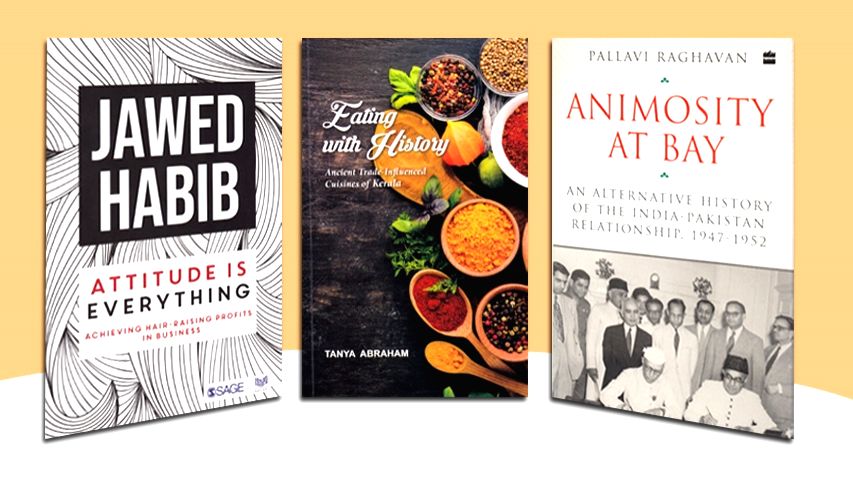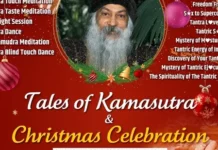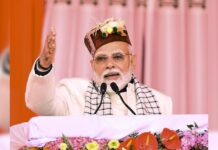VISHNU MAKHIJANI
NEW DELHI: Strange as it may seem to today’s generation, India and Pakistan were at peace in the first five years after the partition of the sub-continent in 1947 in spite of the horrendous killings that had taken place after the separation. A refreshing new book details these years and the subsequent downward spiral.
Next, read about a hairdressser who dared to be different and built up an empire of 900 salons and 65 hair academies across 24 states and 121 cities in India – as also in Dubai, Singapore, Nepal and Bangladesh — all valued at $30 million. And finally, explore the original Spice Route — the cuisines of Kerala.
Diversity rules the IANS Bookshelf this weekend. Immerse yourself!
1. Book: Animosty At Bay – An Alternative History Of The India-Pakistan Relationship, 1947-1952; Author: Pallavi Raghavan; Publisher: HarperCollins; Pages: 247; Price: Rs 699.
“An alternate history of the India-Pakistan relationship is long overdue. It’s terms of reference are frayed and well-worn, and its trends are monotonously predictable. India and Pakistan have entered into three full-scale wars…they point out each others’ shortcomings at the United Nations and spend vast sums of money on maintaining armies on the border….A slice of land, approximately 90,000 square miles in size (Kashmir), has been contested between the two for more than six decades. The dialogue process moves along in fits and starts and is seen as being held hostage by a variety of interests that benefit from a further deterioration of the relationship,” writes Raghavan, an Assistant Professor of International Relations at Delhi’s Ashoka University.
But it wasn’t always like this. In the first five years after Partition (1947-52), “what was acknowledged on both sides was that the way to a lasting stability lay in finding finding answers that could lay the ghosts of partition once and for all. And, to some extent at least both governments made concerted efforts to bring this about”, writes Raghavan in this extensively-researched book.
It details the Nehru-Liaquat Pact between the two Prime Ministers that inter alia permitted refugees to return to dispose of their property, the return of abducted women and looted property, derecognised forced conversions and confirmed minority rights. Most importantly, a pact was signed on sharing the Indus Waters and has endured till this day.
The entry of the Pakistani Army, initially through the back door with the C-in-C, General (later Field Marshal) Ayub Khan, initially becoming the Defence and Home Minister and later overthrowing President Iskandar Mirza in a coup, upset the delicate balance and saw a steady downswirl in sub-continental relations.
Still, all is not lost.
If, in the immediate post-partition conditions, policy makers of India and Pakistan “could conclude that the best remedy for the situation called for a series of detailed negotiations about how to put to rest the lingering questions arising out of the partition, these arguments can also serve as a relevant guide to the maze of India-Pakistan relations today”, Raghavan suggests.
It’s a rare voice of sanity in an otherwise programmed world.
2. Attitude Is Everything – Achieving Hair Raising Profits in Business; Author: Jawed Habib; Publisher: Sage; Pages: 212; Price: Rs 395.
“As I ventured out of the coziness of my father’s salon by way of attending and addressing seminars or by curring hair in other salons, I realised that there is a tremendous opportunity to grow and spread the business of providing good, hygienic and proper hairstyling to Indians,” writes Habib, a true self-made giant in his lifetime.
It wasn’t easy because no one at the time thought that uniform hairdressing services could be replicated across salons and then multiplied across the country. Hairdressers worked in their salons day and night but hardly taught anyone how to do the same work efficiently because there was a sense of insecurity – what if my junior overtakes me?
That’s not me, declared Habib.
“My life is like a running train. It started from one station and only I know when my terminal station will come. Many have boarded it and alighted too but my train has kept on moving. From 1 salon to 900 salons, 1 academy to 65 academies, 1 city to 121 cities, 1 state to 24 states and 1 country to 4 countries. I will not stop. I am moving on. I request my partners to be part of my success story. I will not stop. I do not know how to stop,” Habib concludes.
Way to go!
3. Book: Eating with History – Ancient Trade-Influenced Cuisines of Kerala; Author: Tanya Abraham; Publisher: Niyogi Books; Pages: 202; Price: Rs 550.
Tanya Abraham grew up in a small town in Kerala in a big ‘tarawad’ (family dwelling that housed not only her large family but also soaked in the town’s happenings. At its core, was her grandmother’s kitchen. It was called ‘kusinchya’, a Portuguese derivative of the word kitchen, and it was from here that the main artery ran to nourish the soul of the household.
There couldn’t be a better grounding for a foodie as Abraham dishes out a culinary trail that is extensive and varied as it can get – from Jews of the Paradesi and Malabari sects, Syrian Christians, Muslims, Anglo-Indians, Latin Catholics and others who mingled with and evolved from the local populace – and the innumerable traders that flocked the state.
“In the heart of Kerala, lies the love of its people for food. As cultures and traditions thrived in the state, food found a prominent position in people’s lives. Influenced greatly by traditions, religious beliefs and trade it led to the emergence of a variety of cuisines,” writes Abraham in this tour-de-force along the original Spice Route. IANS






